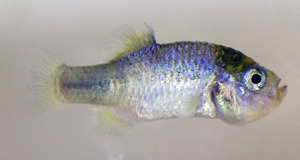Catarina pupfish facts for kids
Quick facts for kids Catarina pupfish |
|
|---|---|
 |
|
| The last Catarina pupfish, which died in 2014 | |
| Conservation status | |
| Scientific classification |
The Catarina pupfish (Megupsilon aporus) was a tiny type of fish. Scientists first described it in 1972. This fish lived only in one special spring in Nuevo León, Mexico. It was a unique species found nowhere else.
Sadly, the number of Catarina pupfish started to drop quickly. To try and save them, some fish were moved to aquariums in the late 1980s and early 1990s. But it was very hard to keep them alive in captivity. By 1994, the Catarina pupfish was extinct in the wild. This means there were no more left in their natural home. Slowly, the fish in aquariums also died out. The very last male Catarina pupfish died in 2014. With its death, the entire species became extinct.
Besides being small, the Catarina pupfish had some interesting features. It didn't have pelvic fins, which are like small fins on a fish's belly. Males had a unique way of showing off during mating, called "jaw-nudging." They also had a dark spot on their back. What's more, male and female Catarina pupfish had different numbers of chromosomes.
Why the Catarina Pupfish Disappeared
The Catarina pupfish is now completely extinct. It used to live in only one spring in southwestern Nuevo León, Mexico. Another fish, the Potosi pupfish (Cyprinodon alvarezi), also lived in the same spring.
In 1994, the spring where both fish lived almost dried up. This made both species "almost extinct" in the wild. A few fish were found in a small side spring later that year. However, scientists later confirmed that both species had become extinct in their natural habitat by 1994. The IUCN Red List, which tracks endangered species, also lists them as extinct in the wild.
Mexico's official list of at-risk species from 2010 said the Catarina pupfish was "Probably extinct in the wild." This category is for species that experts believe are extinct. If a species like this were ever found alive again, it would immediately get legal protection.
To try and save the Catarina pupfish, a small number were taken into captivity in 1987 and 1992. But, as mentioned, they were very hard to keep alive. Aquariums in Mexico, Europe, and the United States tried to keep colonies. However, these groups of fish slowly died out.
By December 2012, only one group of about 20 fish remained. They were at the Children's Aquarium at Fair Park in Dallas, Texas. In 2013, the last female in this group died. Only four eggs hatched, and all of them were male. This meant the species was functionally extinct, as they could no longer reproduce.
The last remaining males were sent to a lab at the University of California, Berkeley. Scientists tried to breed them with Cyprinodon alvarezi. They hoped to create a hybrid population to save some of their genes. This breeding was successful at first, creating all female offspring. But sadly, none of the next generation survived for more than a few weeks. This was likely due to problems with the hybrid fish. In 2014, the very last male Catarina pupfish died in that lab. With its death, the entire species was gone forever.
Saving the Potosi Pupfish
Many Potosi pupfish, which shared the same spring, were also brought into captivity. They did much better than the Catarina pupfish. Today, several aquariums and private fish keepers maintain populations of Potosi pupfish. These efforts are for conservation. These fish could potentially be reintroduced to the wild in the future.
The story of the Catarina pupfish and Potosi pupfish shows a bigger problem in Mexico. By 2008, about 40% of Mexico's over 500 freshwater fish species were at risk. Around 30 species had already become extinct, mostly in the last 50 years. Many fish extinctions are due to too much fishing, water drying up, habitat loss, and competition from new species. Mexico's unique inland fish are especially vulnerable. This is because many species, like the Catarina pupfish, live only in isolated springs or small water systems.
Fish Features and Behavior
The Catarina pupfish was very small, growing to about 4 centimeters (1.6 inches) long. It was one of the smallest fish in North America. Male fish ready to mate had shiny blue heads and sides. They also had a dark spot near their tail. Female fish were golden-olive with a faint stripe on their side. As mentioned, they did not have pelvic fins.
Being very small and lacking pelvic fins are also features of the Devils Hole pupfish. Some other types of pupfish from other parts of the world also lack pelvic fins.
Scientists studied the Catarina pupfish's behavior and unique body features. They found that its aggressive and mating behaviors were similar to other North American pupfish. However, Catarina pupfish males did not defend their breeding areas. This was different from other pupfish.
Male Catarina pupfish often flared their gill covers during fights. During courtship, they would "jaw-nudge." This meant they repeatedly moved their jaws forward and back, sometimes touching the female's head. These behaviors are rare in other North American pupfish.
Scientists believe the Catarina pupfish's unique behavior and body might have been shaped by living with the Potosi pupfish. The larger Potosi pupfish often dominated the smaller Catarina pupfish. This seemed to push the Catarina pupfish into shallow, plant-filled parts of the spring. Scientists think this limited habitat might have influenced how the Catarina pupfish evolved.
Being small and lacking pelvic fins might be connected. Studies show that becoming very small often leads to new body features. There are many examples of how fish, amphibians, and reptiles adapt their bones when they become tiny. This can include losing bones, like the pelvic girdle.


